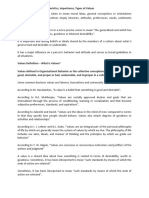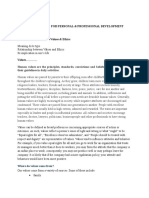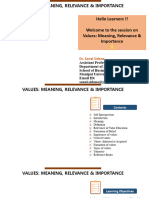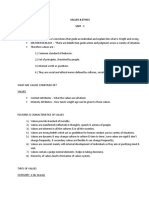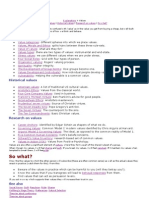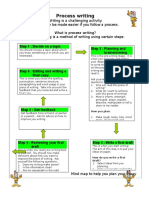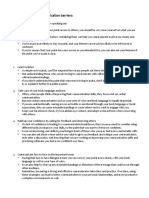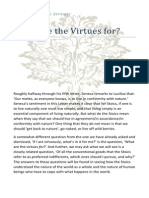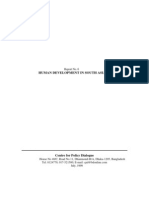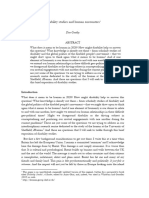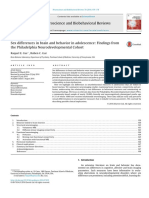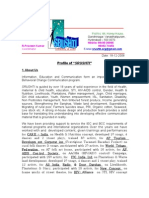HUMAN BEHAVIOR actions.
Ethics evaluates those actions, and the
values that underlie them. It determines which
BBA2001 Human Behavior/MGT2404 Managerial Psychology Martin de Tours School of Management and Economics Assumption University of Thailand
values should be pursued, and which shouldn't.
Chapter 5 Courage is one such value. Those who value courage
are willing to stand up for what they believe, even in
INDIVIDUAL DIFFERENCES: the face of strong condemnation. Courage is a moral
value when it deals with right and wrong conduct.
values)
Main Features of Values
Learning Objectives:
• Define values Values are beliefs. But they are beliefs tied
inextricably to emotion, not objective, cold ideas.
• Describe the main features of values
• Explain the different levels of values
Values are a motivational construct. They refer to
• Evaluate dominant values that matter in
the desirable goals people strive to attain.
one’s life
• Understand the effects of values toward
Values transcend specific actions and situations.
consumption and workplace conditions
They are abstract goals. The abstract nature of
• Solve a puzzle and reflect on personal values
as a consumer and future worker values distinguished them from concepts like
norms and attitudes, which usually refer to
specific actions, objects, or situations.
VALUES
Values are basic and fundamental beliefs that guide Values guide the selection or evaluation of
or motivate attitudes or actions. They help us to actions, policies, people, and events. That is,
determine what is important to us. Values describe values serve as standards or criteria.
the personal qualities we choose to embody to
guide our actions; the sort of person we want to be; Values are ordered by importance relative to one
the manner in which we treat ourselves and others, another. People’s values form an ordered system
and our interaction with the world around us. They of value priorities that characterize them as
provide the general guidelines for conduct. individuals. This hierarchical feature of values also
distinguishes them from norms and attitudes.
Values in a narrow sense is that which is good,
desirable, or worthwhile. Values are the motive
DIFFERENT LEVELS OF VALUES
behind purposeful action. They are the ends to
Values do not operate just at a personal level but
which we act and come in many forms. Personal
across other levels too—groups, organizations,
values are personal beliefs about right and wrong
even societies. These levels are all considered to
and may or may not be considered moral. Cultural
have sets of shared values, which exert influence
values are values accepted by religions or societies
across the levels in different ways.
and reflect what is important in each context.
The levels are depicted in the figure below, and they
Values are essential to ethics. Ethics is concerned
include:
with human actions, and the choice of those
• Personal
The materials in this handout are intended only for teaching and learning purposes within the university and not for commercial purposes. 1
� • Groups (or teams in the context of work) Dominant values
• Organizational or sectoral (public, private, Dominant values are those that are widely shared
voluntary) amongst a group, community or culture. They are
• Societal. passed on through sources such as the media,
institutions, religious organizations or family, but
remember what is considered dominant in one
culture or society will vary to the next.
Using the sources listed above, some of your values
could be:
• family—caring for each other, family comes
first
• peers—importance of friendship,
importance of doing things that peers
approve of
• workplace—doing your job properly;
approving/disapproving of ‘foreign orders’
(doing home-related activities in work time
or using work resources for home related
activities)
• educational institutions—the valuing or
otherwise of learning; value of self in
relation to an ability to learn (this often
SOURCES OF VALUES depends on personal experience of
Our values come from a variety of sources. Some of schooling, whether positive or negative)
these include: • significant life events—death of loved ones
• family and the impact on what we value as being
• peers (social influences) important; marriage and the importance
• the workplace (work ethics, job roles) and role of marriage and children;
• educational institutions such as schools
• significant life events (death, divorce, losing
jobs, major accident and trauma, major
health issues, significant financial losses and
so on)
• religion
• music
• media
• technology
• culture
• major historical events (world wars,
economic depressions, etc.).
The materials in this handout are intended only for teaching and learning purposes within the university and not for commercial purposes. 2
� separation and divorce and the value change It is important that you develop an awareness of
that may be associated with this (valuing of what you value, as these values will be important in
self or otherwise) informing your relationships with clients, co–
• religion—beliefs about ‘right and wrong’ workers and employers at the same time it will
and beliefs in gods reflect on your consumption and patronization of
• media—the impact of TV, movies, radio, the products and services.
Internet and advertising on what is
important in our lives, what is valued and CONSUMER VALUES
not valued Consumers usually buy, use and dispose of products
• music—music often reflects what is in a manner consistent with their values. Thus,
occurring in society, people’s response to marketers can know more about what consumers
things such as love and relationships which like if they understand their values. For example,
may then influence the development of our those who value warm relationships are more likely
values to buy gifts and sends cards than those who place
• technology—the importance of technology less value on relationships. Consumers buy personal
or otherwise; the importance of computers care products at The Body Shop because of the
and developing computer skills value the company places on naturalness and health
• culture—a cultural value such as the as well as its emphasis on societal values, such as
importance of individuality as opposed to buying ingredients from poor Brazilian tribes.
conforming to groups
• major historical events—not wasting Marketers can identify groups of consumers who
anything, saving for times of draught, have common set of values different from those of
valuing human life, patriotic values. other groups, a process called value segmentation.
The materials in this handout are intended only for teaching and learning purposes within the university and not for commercial purposes. 3
�For example, Honda segmented the car market and long-lasting feelings and beliefs people have
based on the value consumers place on that contribute to how they experience work. Why
environmental issues and identified some specific are work values important for understanding and
demographic variables that described a particular managing organizational behavior? They reflect
group: primarily married men in their thirties with what people are trying to achieve through and at
high income and a technical job or an interest in work. An employee who thinks he or she should
technology or environment. Marketers can also use learn new things on the job, for example, will be
values to understand the attributes that consumers unhappy working as a toll collector on a highway
in a particular segment are likely to find important because, once he or she has learned how to collect
in a product and that may therefore motivate them tolls, there will be little opportunity for any further
to choose one brand over another. When buying learning. His or her unhappiness may, in turn, cause
clothes, individuals who value status might look for him or her to be less courteous to drivers or more
attributes like price and luxury, whereas those who likely to look for another job. The work values that
value fitting-in with the crowd might look for researchers in organizational behavior have
clothing that is trendy. Moreover, values can identified generally fall into two broad categories:
influence consumers’ reactions to new and different intrinsic work values and extrinsic work values.
products. For example, consumers who value
change highly are likely to react very differently to Intrinsic work values are values related to the nature
innovations like the use of social media in of the work itself. Employees who desire to be
corporation and workplace communication than challenged, learn new things, make important
those who value change less. contributions, and reach their full potential on their
jobs have intrinsic work values. These employees
WORK VALUES want challenging jobs that use all of their skills and
An employee’s personal convictions about what abilities and provide them with responsibility and
outcomes one should expect from work and how autonomy (the ability to make decisions), while at
one should behave at work. Outcomes that people the same time giving them opportunities for
might expect to obtain through work include a personal growth. Employees who desire adventure,
comfortable existence with family security, a sense enjoy being creative, or like helping other people
of accomplishment and self-respect, social also are satisfying intrinsic work values because the
recognition, and an exciting life. Ways people think work they perform—whether it be building new
they should behave at work include being businesses, composing a new symphony, or helping
ambitious, imaginative, obedient, self-controlled, a troubled teen—is what is important to them.
and respectful to others. Work values are general
The materials in this handout are intended only for teaching and learning purposes within the university and not for commercial purposes. 4
�Extrinsic work values function on the other side of R N S I E S A F
the coin. Rather than valuing features of the work
itself, some employees have extrinsic work values, _________________________________________
values related to the consequences of work.
Employees whose primary reason for working is to
earn money, for example, have extrinsic work C E P E A
values. They see work primarily as a means of
providing economic security for themselves and _________________________________________
their families. These employees value their work not
for its own sake but for its consequences. Other
extrinsic work values include a job’s status in the A F I L Y M
organization and in the wider community, social
contacts provided by the job, and the extent to _________________________________________
which a job enables an employee to spend time with
his or her family, pursue a hobby, or volunteer for a
worthy cause. I S N R H D P E I F
Because working is the way most people make a _________________________________________
living, there is an extrinsic element to most people’s
work values, but many people have both extrinsic
and intrinsic work values. Extrinsic and intrinsic D A E N I C U T O
work values differ in their relative importance from
one person to another. An elementary _________________________________________
schoolteacher who likes teaching but quits her job
to take a higher-paying position as a sales
representative for a computer company has N I N S E D K S
stronger extrinsic than intrinsic work values. A social
worker who puts up with low pay and little thanks _________________________________________
because he feels that he is doing something
important by helping disadvantaged families and
their children has stronger intrinsic than extrinsic
H E N T O Y S
work values.
-------------------------------------------------------------------
_________________________________________
Puzzle Up!
Reassemble the letters in the box to form a word.
The words relate to things that people value.
W A R K R D H O
L A H T E H
_________________________________________
_________________________________________
D M R E F E O
V N N O T I M E R N
_________________________________________
_________________________________________
The materials in this handout are intended only for teaching and learning purposes within the university and not for commercial purposes. 5
� P A S I H S P N E _________________________________________
_________________________________________
_________________________________________
_________________________________________
Reflect On…
_________________________________________
Based from the words you have formed above,
which ones that you value the most as a consumer _________________________________________
and as a future worker. You can select more than
_________________________________________
one for each role. You can also add on a value that
is maybe not on the list. Explain your answer. References:
George, J.M. & Jones, G.R. (2012).
Consumer
Understanding and managing organizational
_________________________________________
behavior (6th Edition). Pearson Education, Inc.
_________________________________________
Hoyer, W.D. & MacInnis, D.J. (2007). Consumer
_________________________________________
behavior. Houghton
_________________________________________
Robbins, S. and Judge, T. (2015).
_________________________________________
Organizational behavior. Pearson
_________________________________________
_________________________________________ Don’t forget to recycle.
_________________________________________
_________________________________________
_________________________________________
_________________________________________
_________________________________________
_________________________________________
Future Employee
_________________________________________
_________________________________________
_________________________________________
_________________________________________
_________________________________________
_________________________________________
The materials in this handout are intended only for teaching and learning purposes within the university and not for commercial purposes. 6






